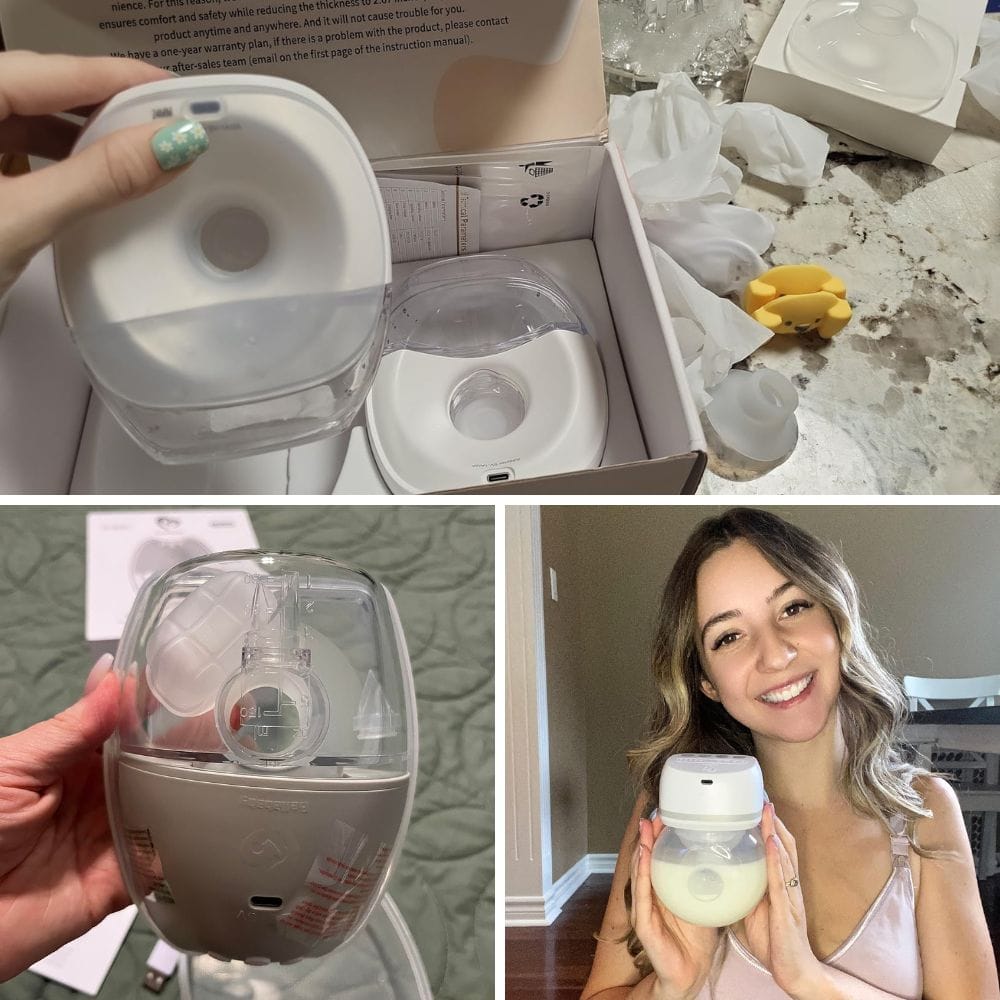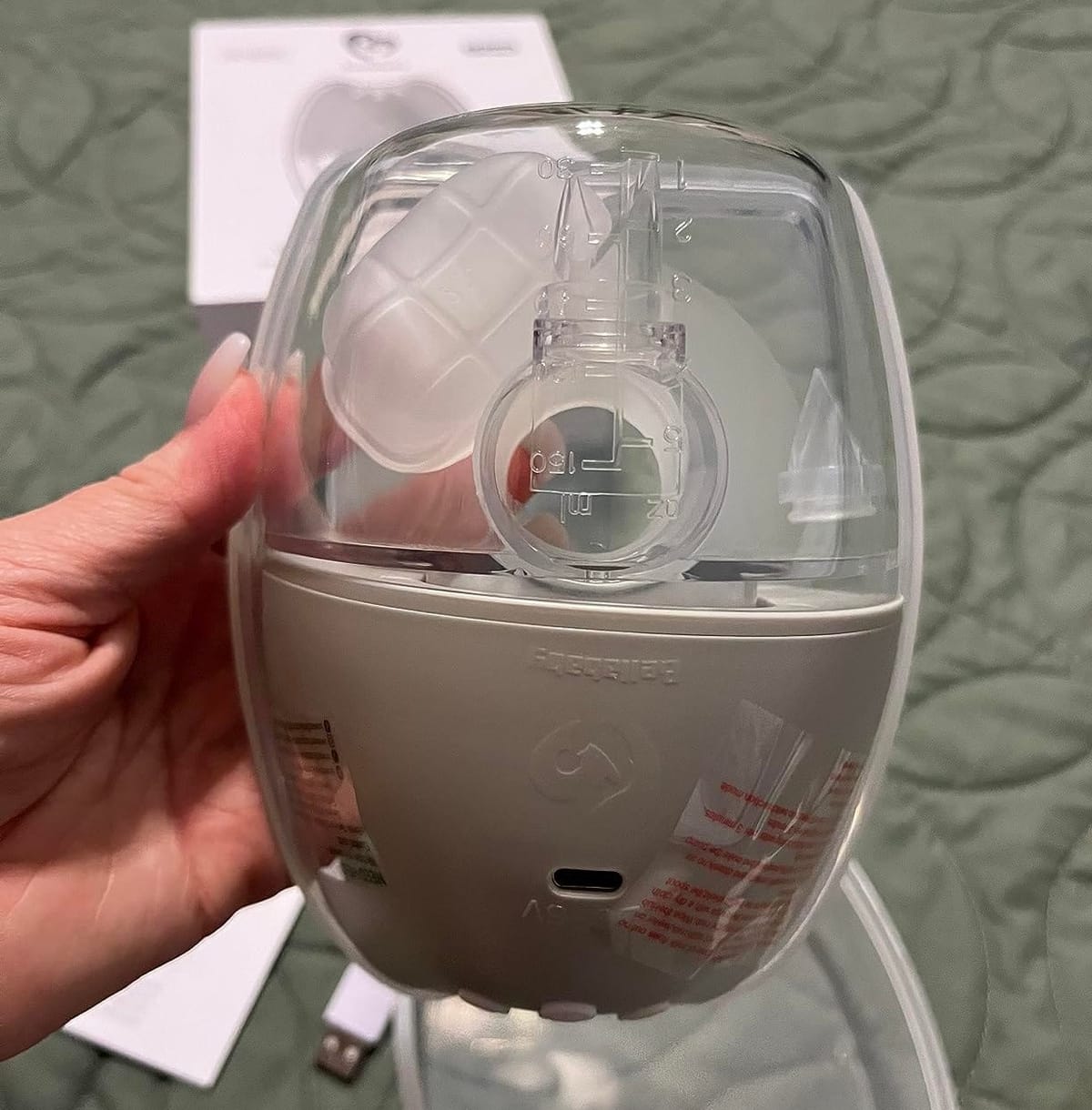Key Takeaways:
- Wearable breast pumps offer unparalleled convenience and mobility, making them ideal for busy moms.
- Traditional breast pumps are known for their powerful suction and efficiency, often preferred for exclusive pumping.
- Choosing between a hands-free breast pump, wearable, and regular breast pumps depends on individual needs, lifestyle, and budget.
When comparing wearable breast pumps to regular ones, it's essential to consider how effectively each type can remove breast milk. Hands-free breast pumps offer convenience but may not always provide the same efficiency as traditional models. Hospital-grade breast pumps, known for their high suction power, can be particularly beneficial for new mothers needing strong milk expression capabilities, while portable breast pumps offer practical solutions for those who pump less frequently.
Portable pumps are often less effective than primary pumps but provide flexibility for multitasking and on-the-go use, making them a practical choice for many mothers. Traditional breast pumps, on the other hand, are typically more robust and effective for maintaining milk supply, especially in work settings.
Traditional electric pumps are known for their strong suction capabilities, which can be crucial for exclusive pumping. Wearable and portable pumps, while convenient, generally do not perform as effectively as primary pumps, so consulting with a lactation consultant can help in making the best choice for your breastfeeding routine.

Introduction
Breastfeeding is a personal journey, and for many mothers, pumping milk becomes an essential part of that experience. With advancements in technology, the market now offers a variety of breast pumps, including wearable breast pumps, hands-free breast pumps, and traditional electric pumps, each designed to optimize breast milk removal. Hospital-grade breast pumps and portable breast pumps are also available, providing options for different needs and settings. This article delves into the differences between wearable breast pumps, portable pumps, and traditional breast pumps, helping you make an informed decision. Traditional electric pumps and wearable and portable pumps will also be compared to highlight their respective advantages and limitations.
Understanding Wearable Breast Pumps

Wearable breast pumps are designed to fit inside your bra, allowing you to pump milk discreetly and hands-free. These pumps are compact, portable, and often come with rechargeable batteries, making them a popular choice for new moms who are always on the go.
Most wearables are equipped with collection cups that fit over the breast, eliminating the need for external bottles and tubing. This design not only makes them more convenient but also reduces the hassle of cleaning multiple parts. Popular brands like Elvie and Willow have set the standard for wearable pumps, offering features that cater to the modern mother's needs.
Traditional Breast Pump: An Overview

Traditional breast pumps, including hospital-grade and electric breast pumps, have been the go-to choice for many mothers for years. These pumps are known for their powerful suction strength and efficiency, making them ideal for exclusive pumpers who need to maintain a steady milk supply.
Traditional pumps often come with a pump motor, tubing, and bottles, which can be cumbersome but are highly effective in collecting milk. They are typically used with a pumping bra to keep the breast shield and bottles in place, allowing mothers to pump hands-free.
Convenience and Mobility
One of the primary advantages of wearable breast pumps is their convenience and mobility, especially when compared to portable breast pumps. Since they fit inside a nursing bra, mothers can pump milk while performing other tasks, whether at home or work. This hands-free feature is a game-changer for busy moms who need to multitask.
On the other hand, traditional pumps require a more stationary setup. While some models offer hands-free options with a pumping bra, they still involve more components, such as tubing and external bottles, which can limit mobility. A portable pump, although less effective than primary pumps, offers practical solutions for mothers who need flexibility while pumping.
Suction Strength and Efficiency
When it comes to suction strength and efficiency, a hospital-grade breast pump often has the upper hand. Hospital-grade pumps, in particular, are known for their powerful suction, which can help mothers produce more milk in less time. This makes them a preferred choice for exclusive pumpers who rely on pumping sessions to maintain their milk supply.
Wearable breast pumps, while convenient, may not offer the same level of suction as traditional pumps. However, they are continually improving, with many models now offering adjustable suction levels to cater to different needs.
Discretion and Comfort
Wearable breast pumps are designed for discretion, allowing mothers to pump milk without drawing attention. This is particularly beneficial for working moms who need to pump during office hours or in public spaces. The compact design and quiet operation of most wearables make them a discreet option.
Traditional pumps, while effective, are often bulkier and noisier, which can make them less discreet. However, they are designed for comfort, with adjustable suction levels and breast shields that ensure a comfortable pumping experience.
Cleaning and Maintenance
Cleaning and maintaining a breast pump, including portable breast pumps, is an important consideration for any mother. Wearable breast pumps typically have fewer parts, making them easier to clean. The collection cups and breast shields can be easily disassembled and washed, reducing the time spent on maintenance.
Traditional pumps, with their multiple components, require more effort to clean. The tubing, bottles, and breast shields all need to be washed and sterilized, which can be time-consuming. However, many mothers find the efficiency and effectiveness of traditional pumps worth the extra effort.
Cost and Insurance Coverage
Wearable breast pumps often come with a hefty price tag, reflecting their advanced technology and convenience. While they are a worthwhile investment for many mothers, the cost can be a barrier for some.
Traditional breast pumps, particularly hospital-grade models, can also be expensive. However, many insurance plans cover the cost of these pumps, making them more accessible. It is advisable to check with your insurance provider to see what options are available.
Battery Life and Portability
Battery life is a crucial factor for mothers who need a portable pump to pump on the go. Wearable breast pumps typically come with rechargeable batteries, offering several hours of use on a single charge. This makes them highly portable and convenient for travel.
Traditional pumps, while effective, often require an electrical outlet, limiting their portability. Some models do offer battery-operated options, but they may not provide the same level of suction as their electric counterparts.
Noise Level
The noise level of a breast pump can be a significant consideration, especially for mothers who need to pump in quiet environments. Wearable breast pumps are designed to be quiet, allowing mothers to pump discreetly without drawing attention.
Traditional pumps, particularly hospital-grade models, can be noisier. While this may not be an issue at home, it can be a concern for mothers who need to pump in public or at work.
Milk Collection and Storage
Wearable breast pumps typically come with integrated collection cups that fit inside the bra, allowing mothers to collect breast milk discreetly. These cups can be easily removed and transferred to storage bottles, making the process seamless.
Traditional pumps use external bottles for milk collection, which can be more cumbersome but offer larger storage capacity. This can be beneficial for mothers who need to pump large volumes of milk.
Comfort and Fit
Comfort is a crucial factor when choosing a breast pump, and a hands-free breast pump can offer added convenience. Wearable breast pumps are designed to fit inside a nursing bra, providing a comfortable and discreet pumping experience. The breast shields are typically soft and flexible, ensuring a good fit.
Traditional pumps offer a range of breast shield sizes to ensure a comfortable fit. The adjustable suction levels also allow mothers to find a setting that is comfortable and effective.
Customization and Settings
Wearable breast pumps often come with customizable settings, allowing mothers to adjust the suction level and pumping rhythm to suit their needs. This can help optimize milk production and ensure a comfortable pumping experience.
Traditional pumps offer a wider range of settings and customization options, making them highly effective for exclusive pumpers. The ability to adjust the suction strength and pumping rhythm can help mothers produce more milk and maintain their supply.
Durability and Longevity
Durability is an important consideration when investing in a breast pump. Wearable breast pumps are designed to be durable and long-lasting, with many models offering warranties for added peace of mind.
Traditional pumps, particularly hospital-grade models, are known for their durability and longevity. These pumps are built to withstand frequent use and are often used by multiple mothers in hospital settings. A hospital-grade breast pump is designed for high suction power, making it advantageous for new mothers needing strong milk expression capabilities.
Support and Resources
Having access to support and resources, including information on wearable and portable pumps, can make a significant difference in a mother’s pumping journey. Wearable breast pump manufacturers often provide online resources, including instructional videos and customer support, to help mothers get the most out of their pumps.
Traditional pump manufacturers also offer extensive support and resources, including lactation consultants and customer service. This can be particularly beneficial for new mothers who need guidance and support.
Insurance Coverage and Affordability
The cost of breast pumps can be a significant factor for many mothers. Wearable breast pumps often come with a higher price tag, reflecting their advanced technology and convenience. However, some insurance plans may cover the cost of these pumps, making them more affordable.
Traditional pumps, particularly hospital-grade models, can also be expensive. However, many insurance plans cover the cost of these pumps, making them more accessible. It is advisable to check with your insurance provider to see what options are available.
Popular Brands and Models
There are several well-known brands and models of portable breast pumps, wearable, and traditional breast pumps on the market. Popular brands like Elvie and Willow have set the standard for wearable pumps, offering features that cater to the modern mother’s needs.
Traditional pumps, such as those from Medela and Spectra, are also highly regarded for their efficiency and effectiveness. These brands offer a range of models to suit different needs and preferences.
User Reviews and Testimonials
User reviews and testimonials can provide valuable insights into the performance and reliability of different breast pumps. Many mothers share their experiences online, offering tips and advice on choosing the right pump.
Wearable breast pumps often receive positive reviews for their convenience and portability, while traditional pumps are praised for their powerful suction and efficiency. Reading user reviews can help you make an informed decision.
Practical Examples and Case Studies
Practical examples and case studies can provide real-world insights into the benefits and challenges of different breast pumps, including the use of a portable pump. For example, a working mother may find a wearable pump more convenient for pumping at the office, while a stay-at-home mom may prefer the efficiency of a traditional pump.
Case studies can also highlight the experiences of mothers with different needs and preferences, helping you understand the pros and cons of each type of pump.
Expert Opinions and Recommendations
Lactation consultants and healthcare professionals can provide expert opinions and recommendations on choosing the right breast pump, including whether a hospital-grade breast pump might be suitable for you. They can offer personalized advice based on your individual needs and circumstances.
Consulting with a lactation consultant can help you understand the benefits and limitations of different pumps, ensuring you make an informed decision.


Are wearable breast pumps as effective as traditional pumps?
Wearable breast pumps are designed for convenience and mobility, but they may not offer the same level of suction as traditional pumps. However, many models now offer adjustable suction levels to cater to different needs.
Can I use a wearable breast pump for exclusive pumping?
While wearable breast pumps can be used for exclusive pumping, traditional pumps are often preferred for their powerful suction and efficiency. It is advisable to consult with a lactation consultant to determine the best option for your needs.
Does insurance cover the cost of wearable breast pumps?
Some insurance plans may cover the cost of wearable breast pumps, but coverage varies. It is advisable to check with your insurance provider to see what options are available, including whether a hospital-grade breast pump is covered.

Choosing between a wearable breast pump, wearable and portable pumps, and a regular one depends on your individual needs, lifestyle, and budget. Wearable pumps offer unparalleled convenience and mobility, making them ideal for busy moms. Traditional pumps, on the other hand, are known for their powerful suction and efficiency, often preferred for exclusive pumping. By considering factors such as convenience, suction strength, discretion, and cost, you can find the right pump to support your breastfeeding journey.










